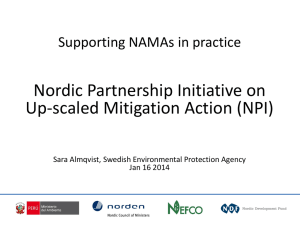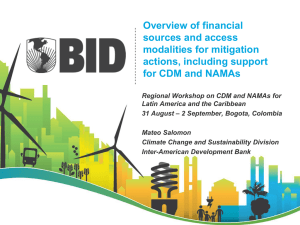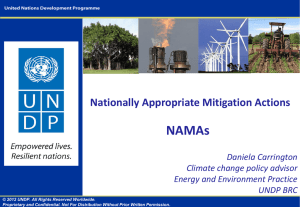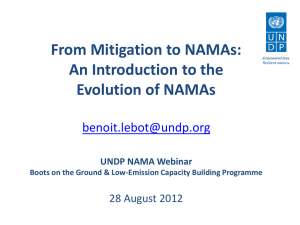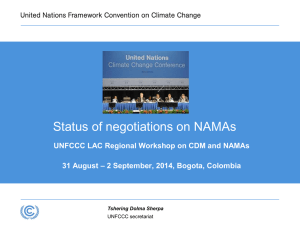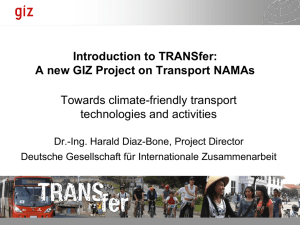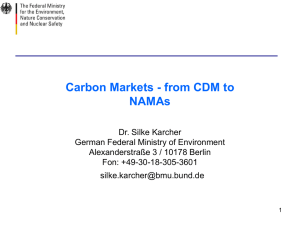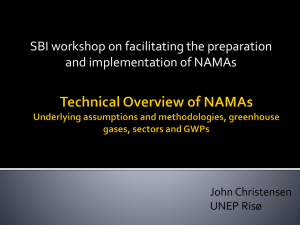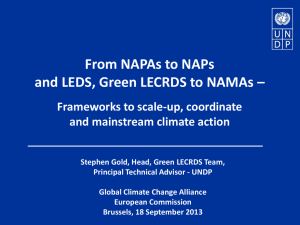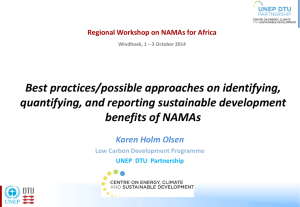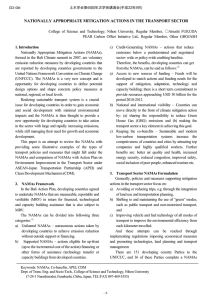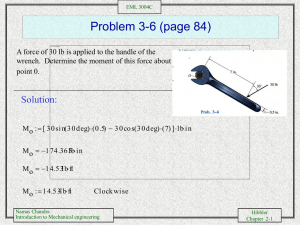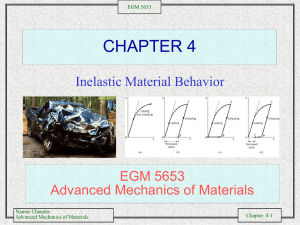Nationally Appropriate Mitigation Actions - ACP
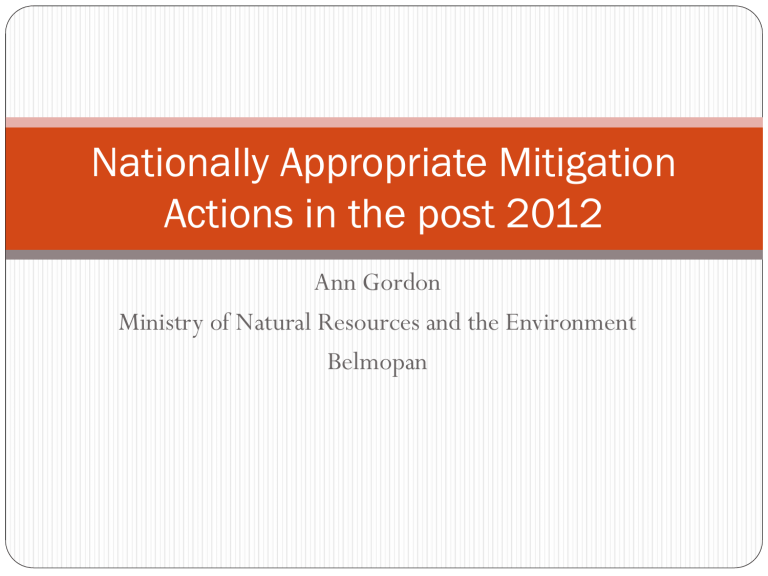
Nationally Appropriate Mitigation
Actions in the post 2012
Ann Gordon
Ministry of Natural Resources and the Environment
Belmopan
Nationally Appropriate Mitigation
Actions (NAMAs)
Content
Origin
What is a NAMA
Scope of NAMAs
Cancun Agreement and NAMAs
Current developing countries’ proposed
NAMAs
Origin of NAMAs
Paragraph 1 (b) (ii) of the Bali Action Plan calls for “Nationally appropriate mitigation actions’
by developing country Parties in the context of sustainable development, supported and enabled by technology, financing and capacity building, in a measurable, reportable and verifiable manner”.
What is a NAMA
Appendix II to the
Copenhagen
Accord
Source: ECOFYS-Nationally Appropriate
Mitigation Actions
NAMAs and the Copenhagen Accord
Developed countries agreed to provide 30 billion
USD in fast track financing between 2010 and
2012 and to mobilize 100 billion per year by 2020.
No decisions made in 2009 on modalities and required institutions.
Mechanisms to raise and distribute funds, and procedures to measure, report and verify NAMAs must be in place
Cancun Agreement and NAMAS
Schedule for establishing guidelines for measuring reporting and verification
A registry for matching NAMAs and support is established
(registry will record NAMAs and their support)
Creation a fund to finance mitigation and adaptation actions
New technology transfer mechanisms
Creation on “new market based mechanisms” – no explicit text on
CDM
Individual pledges submitted under Copenhagen Accord anchored under UNFCCC
Type of NAMA Description
1. Voluntary and unilateral NAMA associated with actions that developing countries would take voluntarily and unilaterally without support from developed countries
2. Supported Actions that require support from developed countries
3. Carbon Credit NAMAs NAMAs associated with actions that developing countries are willing to take for the purpose of obtaining carbon credit as an outcome of implementing such actions.
National Climate Change Action Plan or Low Emission
Development Strategies
Sectoral Strategy
Sectoral Strategy
INDUSTRY
Sectoral Strategy
BUILDINGS
Implementation of building codes
Define and implement building codes
Create institutions to support definition, implementation and enforcement
Promotion of solar thermal use
Conduct study and implement
Information and capacity building
Incentives for efficient appliances
Implement labeling regulations
Source ECOFYS: Nationally Appropriate Mitigation Actions
Financing of Nationally Appropriate Mitigation Actions
REGISTRY
OFFICIAL DEVELOPMENT
ASSISTANCE
SUPPORTED NAMAS
UNILATERAL
NAMAS
MARKET
BASED
MECHANISMS
BILATERAL
MULTILATERAL
Adapted from ECOFYS
GREEN CLIMATE
FUND
DOMESTIC
FINANCING
CARBON
CREDITS
Decision postponed to
COP 17
Directly Supported NAMAs
Can be
Projects (e.g. Bus Rapid Transit lane)
Programmes (e.g. energy efficient lighting program)
Policy instrument and tools including:
Pilot programmes in local communities
Energy efficiency standard in buildings and transport sectors
Appliance labelling and provision of subsidies
Phasing out small inefficient power plants
Inefficient cement and steel plants
Replacement of incandescent light bulbs with compact fluorescent bulbs
Removing fuel subsidies
Appropriate taxation policies
Development and implementation of a strategy
National mitigation target
Current Developing Countries’ Proposed
NAMAs
Become climate neutral around 2020
• Costa Rica, Maldives
Percentage reduction of national emission below BAU or base year in 2020
• Brazil, Indonesia, Israel, Marshal Islands, Mexico, Moldova,
Singapore, South Africa, South Korea
Percentage reduction of intensity (national emission per GDP) in
2020 from 2005
• China, India Detailed list of projects
• Congo, Ethiopia, Jordan, Macedonia, Madagascar, Morocco,
Sierra Leone
What is needed?
NAMAs should be based on well developed national and
/or sectoral strategies.
Initiate process of planning for and preparing for NAMAs and put in place necessary institutional arrangements to support such an endeavour
Need to ensure stakeholder consultation in the process and preparation of NAMAs.
Conclusions
NAMAs should be based on well developed national and/or sector strategies
– Strategic, long-term, transformational measures
– Allows for comprehensive, packages of actions
– Can also address difficult CDM sectors (e.g. transport, buildings)
– Can consists of several components
– Can lead to carbon credits or not
Learn from existing experience in development finance
NAMAs could also take place outside of UNFCCC (e.g. bilateral and multilateral donors)
NAMAs can be implemented through the use of domestic resources and funding through the Green Climate Fund, complemented by the use of the market mechanisms, in a balanced manner.
PoAs under the Clean Development Mechanism regarded as predecessor of a future NAMA mechanism
